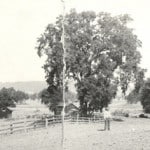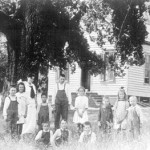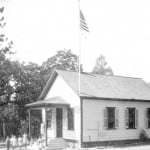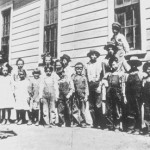Pope Valley, Tidings
Pope Valley Schools: A Primer
This is an excerpt of an article written by the late Alice Carey, an award-winning architect and preservationist who lived in Pope Valley for many years. It was first published in the Vol. 19, No. 1 edition of Tidings, our quarterly newsletter. To get your copy of Tidings, become a member today!

In 1849 the first Napa County School, William H. Nash Tucker School was founded under a fir tree across from the Bale Mill. Nine years later there were 903 Napa County children in thirteen public one-room schoolhouses, state taxes for schools were levied at five cents per one hundred dollars, and the first Pope Valley School was constructed.By 1890 there were fifty-two school districts in Napa County, and five one-room schools in the vicinity of Pope Valley as follows: Pope Valley (later known as Central), located at Barnett Road and Chiles Pope Valley Road; Upper Pope Valley, (later known as Aetna Springs) located on Aetna Springs Road, Olive located at the intersection of Ink Grade and Pope Valley Road; Hardin located on Pope Canyon Road; and Oat Hill Joint, on the former Oat Hill Mine Road.

Of these schools three, Central, Olive, and Hardin, were located within William Pope’s original 1841 Rancho Locoallomi land grant. In 1940 these three independent districts merged. Central and Olive school properties were sold. The Haug family, who had attended Olive School for several generations, bought it and dismantled it for lumber. At the time all students were moved to the Hardin School location that became the Pope Valley Unified School District, now a two-room schoolhouse. Seven years later, daughter Ramona Haug (now the well-known St. Helena resident Ramona Decker) was recruited from teachers college to teach fourth through eighth grades at Hardin. At the same time the late Joe Callizo, destined to become Pope Valley’s botanist, geologist, and historian, began his education and life-long love of learning at the Hardin schoolhouse.

The consolidation of Pope Valley’s schools was part of a national movement to eliminate one-room schoolhouses. Originally initiated by President Theodore Roosevelt, the movement gained momentum after WWII when road construction and school bus transportation rendered rural schoolhouses within walking distance to farms unnecessary. Of the 54 Napa County School Districts existing in 1895, only 13 remained by 1954…
In 1841 William “Julian” Pope, a hunter and trapper from Kentucky, obtained a land grant from the Mexican government. He became the first white settler in the area when he located his family to Rancho Locoallomi, a six-mile long, three-mile wide parcel. In 1853 the James Dealy family came to the valley. Three years later James Dealy granted both land and his daughter Rebecca Frances Dealy’s hand in marriage to Robert Stephens Hardin. Also a Kentuckian, Hardin relocated to California during the 1849 Gold Rush before moving to Pope Valley in 1854.
That same year toll-road builder John Lawley found cinnabar, an ore from which mercury is extracted, on the valley floor. This discovery led to development of a mining industry that lasted through WWI and included the Phoenix, Oat Hill, Silver Bow, Aetna, and White Hill Magnetite Mines. Three mineral springs; Aetna, Walters, and Samuel’s brought bottled water and tourism to Pope Valley from 1877 through 1972. However Pope Valley was primarily an agrarian community raising cattle, horses, sheep, and hogs. Wheat was the major crop.

Of all the pioneer Pope Valley families, the Hardins remain today. Through generations they played active roles in school affairs…On June 6, 1900, the Napa Daily Journal reported a tie in the Hardin School Trustee election; brothers Joseph and Thomas Hardin each received ten votes. Sadly, Thomas passed away that autumn. Jeanne Hardin served for many years as the Clerk of the Board of Trustees of the Pope Valley Union District during the 1940s and 1950s. Jim Hardin currently serves on the Board of Trustees…
After Central, Olive, and Hardin merged, the Pope Valley Unified School District archives record discussions of the lack of funds available to build a new facility. The board chose instead to add rear, front, and side additions to Hardin to accommodate the influx of new students. Several decades later the District was able to relocate to a modern facility, the current Pope Valley School. In 1971 Hardin closed its doors.

The old school remained vacant until 1994 when owner Robert Magilligan converted it to a residence. He removed the front and side additions restoring its original appearance. The Hardin School received a Napa County Landmarks Award of Merit in 2009, and has been nominated to the California State Register of Historic Places. It joins the Haus Blacksmith Shop, Aetna Springs Resort, the Pope Valley Store and Garage, Pope Valley Winery and Litto’s hubcap ranch as one the many tangible remnants of the Valley’s proud history.


